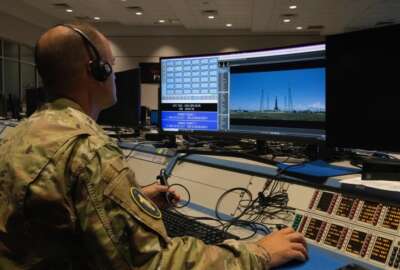The Defense Department’s 2024 budget highlighted the Pentagons’ priorities for upgrading its technologies through a combination of research, development, technology and science. Although the topline numbers for the department show an all-time high of $842 billion, leaders say the increase of $26 billion over last year’s enacted but is basically flat due to inflation.
The combined Navy and Marine Corps budget represented a 4.5% hike at $255.8 billion. The Army requested $185.5 billion, a 4.6% increase over the Army’s $178 billion budget last year. And the Air Force, including Space Force, wants $259 billion with $215 billion for the Air Force and $30 billion for the Space Force.
At the McAleese fiscal year 2024 Defense Programs conference on March 15, leaders from across the DoD had a chance to expand on their priorities for the requested budget.
The Army has procurement front and center as it attempts to ramp up its production of munitions while simultaneously putting money into advanced equipment and technologies.
Army Secretary Christine Wormuth said multi-year contracts were helping the Army scale up production.
“We’ve used multi-year procurement authorities in the past on things like some of our helicopter programs. And that’s given a lot of stability to the industrial base. It’s generated predictability for industry and it’s also brought cost savings to us in the Army. So needless to say, I’m a fan of multi-year procurement authorities,” Wormuth said at the conference.
Although the Army asked for less money for research and development than it got in fiscal 2023, it still has plans to develop upgrades to its technical abilities. It requested $15.8 billion for R&D in 2024, down from $17.2 billion in the 2023 enacted budget.
“We’re really looking at investing in research that’s going to provide our soldiers with advanced munitions and advanced capabilities, particularly for deep sensing and contested logistics,” Wormuth said. “For example, we’re looking to advancements in science and technology to enable small, lightweight and low cost interceptor technologies for increased magazine depth, to improve our deep sensing capabilities.”
The Navy budget request stands out for its dominant push towards expanding its fleet. Part of that expansion includes a requested $26.9 billion for R&D, nearly a billion dollars more than the Navy got last year as it seeks to build a more technologically capable fleet.
Navy officials say R&D remains fundamental to major acquisition programs. The service’s priorities include continuing upgrades the Columbia class ballistic submarines, which form part of the nuclear deterrent strategy. Future R&D priorities include investments in an aircraft carrier, surface ships, submarines, and logistics vessels, unmanned system, electromagnetic warfare, and cyberspace warfare.
“I recognize that much of the innovation that’s taking place over the last 10 to 20 years has truly been in the private sector,” said Navy Secretary Carlos Del Toro. “We want to work with the private sector to integrate that technology and talent with the investments that we make in government, perhaps even in the higher risk areas for success to be able to bring acquisition programs to our sailors and Marines that much faster.”
Like the Navy, the Air Force asked for increased funds for R&D. It wants five billion dollars more than it got last year in an effort to upgrade existing technologies and adopt cutting edge equipment. That’s paired with an acquisition budget hike of $1.3 billion to $35.4 billion, a 3.8% boost.
The funding would further the development of a new group of fighter aircraft known as “Next Generation Air Dominance” and its power plant known as Next Generation Adaptive Propulsion. Its package of capabilities will include both manned and unmanned aircraft.
The Air Force also is proposing to upgrade and develop the Sentinel system, the replacement for its current fleet of intercontinental ballistic missiles, and part of the nuclear triad. The department also wants upgraded missile warning and tracking systems and expansion of its B-21 Raider long-range bomber group of aircraft.
Copyright
© 2024 Federal News Network. All rights reserved. This website is not intended for users located within the European Economic Area.


